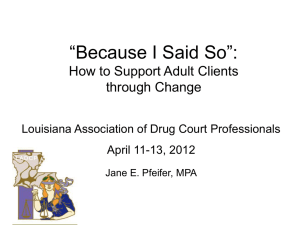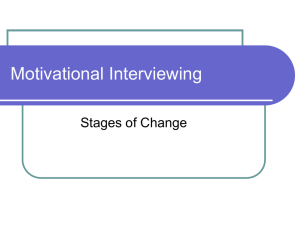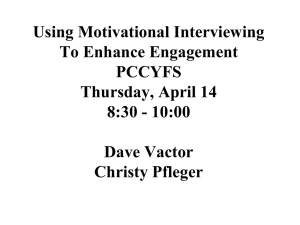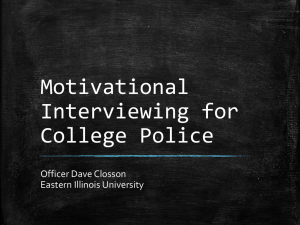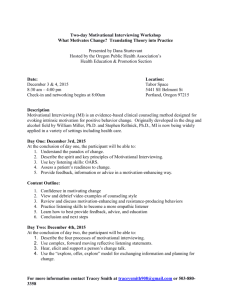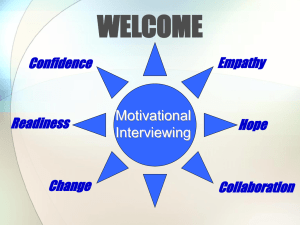Motivational Interviewing - Michigan Cancer Consortium
advertisement
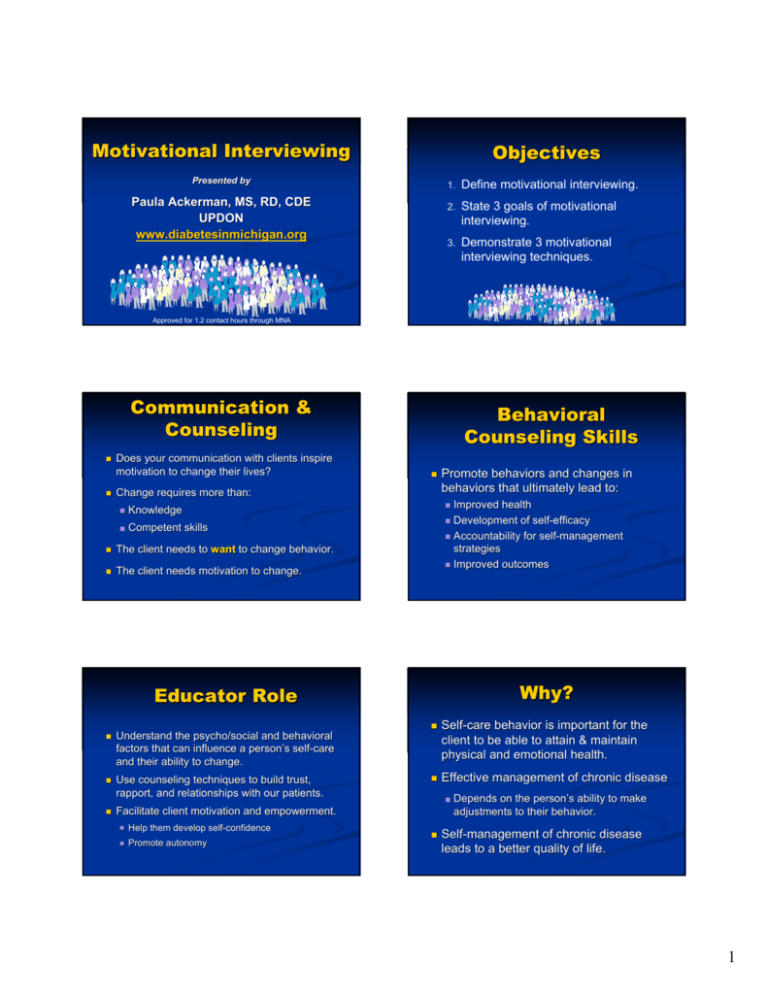
Motivational Interviewing Objectives Presented by Paula Ackerman, MS, RD, CDE UPDON www.diabetesinmichigan.org 1. Define motivational interviewing. 2. State 3 goals of motivational interviewing. 3. Demonstrate 3 motivational interviewing techniques. Approved for 1.2 contact hours through MNA Communication & Counseling Does your communication with clients inspire motivation to change their lives? Change requires more than: Behavioral Counseling Skills Improved health Development of selfself-efficacy Accountability for selfself-management strategies Improved outcomes Knowledge Competent skills The client needs to want to change behavior. The client needs motivation to change. Promote behaviors and changes in behaviors that ultimately lead to: Why? Educator Role Understand the psycho/social and behavioral factors that can influence a person’s selfself-care and their ability to change. Use counseling techniques to build trust, rapport, and relationships with our patients. Facilitate client motivation and empowerment. Help them develop selfself-confidence Promote autonomy SelfSelf-care behavior is important for the client to be able to attain & maintain physical and emotional health. Effective management of chronic disease Depends on the person’s ability to make adjustments to their behavior. SelfSelf-management of chronic disease leads to a better quality of life. 1 Basic Communication Skills SOLER Delivering the message S: Face your client SQUARELY 7% O: Adopt an OPEN posture 38% tome of voice L: LEAN toward client at times 55% body language E: Maintain good EYE contact R: Be RELAXED The 4 Basic Interview Techniques that Promote Motivation Basic Communication Skills Open Ended Questions Questions that require more than a single answer response: “yes”, “no” Allows client to express concerns and feelings and clinician to understand where they’re coming from. Examples: OARS O: OPEN ended questions A: AFFIRMATIONS R: REFLECTIVE LISTENING S: SUMMARIZE “What brings you here today” “What makes you feel it might be time for a change?” Other Interview Techniques that Promote Motivation NonNon-Verbal Listening Exchange information Reframing Shifting Focus Agreement with a twist Siding with the negative Have client provide solution Set goals words we use Affirmations Identify and acknowledge the client’s strengths. Good rapport builders must be genuine Examples: “So you’ve started walking this past week!” “You didn’t want to come today, but you did!” Remember, most who need to make change have tried and are failed selfself-changers 2 Reflective Listening Listening and trying to understand the client’s point of view Types of Reflection Simple: repeating or paraphrasing client Amplified: interviewer amplifies or exaggerates the issue to the point where the client may disagree with it. DoubleDouble-sided: Interviewer reflects both the current, resistant statement and a previous contradictory statement make by client Even if you disagree with it Communicating (to the client) your understanding of his/her experience, behavior and/or feelings from their point of view. Roadblocks to Reflective Listening Roadblocks to Reflective Listening Ordering, directing or commanding Agreeing, approving, praising Warning, cautioning or threatening Shaming, ridiculing or labeling Giving advice, making suggestions or providing solutions Interpreting or analyzing Reassuring, sympathizing, consoling Questioning or probing Withdrawing, distracting, humoring or changing the subject Persuading with logic, arguing, lecturing Telling people what they should do Disagreeing, judging, criticizing or blaming Ct: I just don’t know how I can lose weight. In: You should do whatever you think is best. Ct: But that’ just it. I don’t know what’s best. In: Yes you do…in your heart. Ct: Well, I feel trapped in my body. In: You should exercise for 10 minutes 3 times a week and see how you feel. Ct: But I don’t have time for that. In: You should find the time. If you don’t you could suffer the complications of diabetes. Its what you need to do to take care of yourself. Ct: I just don’t know how I can do it, how I’d manage. In: I’m sure you’ll do fine. Reflective Listening Key to Motivation Interviewing (MI) Listen to what has worked before and what moves the client forward Focuses on client’s change talk “You’re not quite sure your ready to start and activity program, but you are aware of the health benefits.” 3 Change: From a MI Perspective Summarize Reflect back what the client has told you. Help to build rapport and show your interest in the client Allows you to shift attention/direction Allows client to emphasize something you may have missed Change occurs naturally Formal interventions mirror natural change Interpersonal interactions strongly influence whether change will occur Clinician is a large determinant of treatment outcomes Change: From a MI Perspective The absence or presence of empathic interaction can facilitation or deter change SelfSelf-efficacy and client belief in client efficacy to change does matter What people say about change is important. Motivation The mental process, function, or instinct that produces and sustains incentive or drive in human and animal behavior. Components Resistance Hopelessness Low selfself-efficacy Excitement about problematic behaviors Willing: degree of discrepancy between current behavior and future values Able: confidence for change Ready: has to do with priorities Signs of CounterMotivation Counter-Motivation Interrupting Ignoring Arguing Denying Talking off subject Daydreaming Reminiscing Wondering aloud 4 Dilemma of Change Ambivalence Ambivalence Best to id/explore what client wants Feeling 2 or more ways about someone or something First step of change Normal aspect of human behavior ApproachApproach-approach ApproachApproach-avoidance Double approachapproach-avoidance Advantages Optimism Intention First goal: increase the discrepancy between current status and desired goal Second goal: increase change talk Avoid forcing a resolution Client needs to be the one voicing the argument for change. Decisional Balance 4 Categories Disadvantages Resolving ambivalence is the key to change Change Talk Don’t assume you know the benefits/costs of change for client Benefits of Smoking Concerns with smoking Concerns with quitting Benefits of quitting of status quo of change for change to change Decisional balance Decisional Balance Benefits of Smoking Relaxation Wakes me up I enjoy it Helps me think Concerns with quitting Wt gain Fail at quitting Life not as fun More stressed Concerns with smoking Mother died of cancer Father died of emphysema Personal illness My children will smoke Cost Smell Cough Benefits of quitting Breathe and feel better Please my family Have more money Not embarrassed of smell Motivational Interviewing Introduced by William Miller and Stephen Rollnick in 1990’s. Client centered counseling style for eliciting behavior change which helps clients explore and resolve ambivalence. Acknowledges that people both want and don’t want to change. Clients can perceive both the advantages and disadvantages of changing or continuing with current behavior. Promotes a safe and supportive rapport with the client. 5 Transtheoretical Model of Change PrePre-contemplation Contemplation Preparation Action Maintenance Pre-contemplation “What Problem” Client doesn’t acknowledge problem. Goals: Establish rapport Raise awareness of consequences, causes and cures for problem behavior Raise doubts or concerns in client about selfself-management – develop discrepancy 4 Types of Pre-contemplators Reluctant: lack knowledge or desire to consider change Rebellious: know a lot and don’t like to be told what to do. Resigned: have given up on change Rationalizing: have all the answers Contemplation “Should I Change?” Client acknowledges there’s a problem. Considering possibility of change within next 6 months. Most ambivalence and uncertainty. Contemplation Goals Help client tip the scale toward change Increase confidence in client’s ability to change Identify benefits of change – decisional balance Encourage support networks Elicit and summarize selfself-motivational statements of intent and commitment. Do best with specific results (labs, lung function tests, etc) Accentuate the positive Often focus on negative aspects of bad behavior Preparation “Can I Change?” Committed to change but still considering what to do. Explore client’s expectations of role in selfselfmanagement Clarify the client’s own goals Help them resolve ambivalence Negotiate for change Help them create an action plan and behavior contract Consider and help lower barriers to change Help client enlist social support. 6 Action “How Can I Change?” Client is actively taking steps to change but has not yet reached a stable state. Acknowledge difficulties and help client problemproblem-solve barriers. Reinforce importance of selfself-management. Help client identify potential barriers to selfselfmanagement. Help them create action plan and coping strategies to overcome these barriers Maintenance “Is It Worth It?” Support lifestyle changes. Affirm the client’s commitment. Help client practice and use coping strategies to prevent relapse. Develop relapse strategy. Review long term goals. *For all stages, maintain contact between visits. Identify support needed Goals of Motivational Interviewing Help person explore behavior for themselves. Analyze cost/benefit ratio of status quo. Decrease potential resistance to change. Help individual move toward being more ready to discuss and potentially begin to make changes in behavior. Motivational Interviewing (MI) A directive, clientclient-centered counseling style for eliciting behavior change by helping clients explore and resolve ambivalence. MI Method of communication (vs (vs set of techniques) Doesn’t teach new coping skills or looking at one’s past. Assist clients in developing realistic strategies to facilitate change. Goals: to elicit and reinforce change talk minimize resistance/resolve ambivalence explore discrepancies between clients experiences and values in a nonnon-threatening environment. “If you treat an individual as he is, he will stay as he is, but if you treat him as if he were what he ought to be and could be, he will become what he ought to be and could be.” --Johann --Johann Wolfgang Von Goethe 7 4 Principles of MI Express Empathy Develop Discrepancy Roll with Resistance Build confidence/support self efficacy Express Empathy Empathy is the most powerful skill to promote behavior change. Show curiosity and caring in truly understanding the client’s experiences. Develop Discrepancy Help client see that some behaviors do not jive with their ultimate goals that are truly valuable to them. Define their MOST important goals. What is the person doing now that is contrary to those goals? Use open ended questions to draw out the client’s feelings. Avoid “why” questions as they imply judgment. Show unconditional positive regard Roll with Resistance Resistance often stems from fear of change Change will not occur without discrepency Normal Need to acknowledge and respect person’s concerns. Explore both positive and negative consequences of change or continuing the current behavior. Explore importance and confidence Scale Roll with Resistance Confront the problem NOT the client. Client may: Argue Interrupt Deny Ignore Build Confidence Increasing resistance is a signal to change interviewing technique. Invite new perspectives. the questions Believe in your client, and their ability to change. Promote selfself-esteem. Their attitudes are shaped by their words not ours. Promote belief in the client’s ability to do skill needed. Focus on client’s skills that show they can do the behavior 8 “FRAMES” Counseling Technique (20 second Interview) What if Client Doesn’t Acknowledge a Problem F = Feedback (direct, factual input) R = Responsibility (you decide) A = Advice (concrete recommendations) M = Menu (Provide options for change) E = Empathy (works from client’s agenda) S = SelfSelf-Efficacy (empowerment, hope) Reinforce the Clients Statement of Change Desire for change Ability to change Reasons to change Need to change Commitment to change Play role of consultant Help client evaluate new input and decide whether there’s a need to change Allow client to be ambivalent about change Allow client to define the problem Assess Readiness Use readiness scale How important is it to the client to change. How confident is the client about making the change. Readiness Scale Readiness Scale How important is it for you to make the change? 7 9 10 Very Ready Ready 1 2 3 4 5 6 7 8 Not important 9 10 Very Important _____________________________________________________________ Prep aratio n tion Somewhat Ready 8 How confident are you that you can make the change? n 6 Actio 5 emp la Unsure 4 C ont Pre-c ontem platio n Not ready 3 tion 2 Con temp la 1 1 2 Not confident 3 4 5 6 7 8 9 10 Very Confident 9 Building Motivation for Change Group A: Group B: Group C: Group D: Questions to elicit change talk: Low importance, low confidence Low importance, high confidence High importance, low confidence High importance, high confidence “Why are you at a ____ and not a zero?” “What would it take for you to go from ___ to a (higher number)? Eliciting Change Talk Ask evocative questions Use readiness to change scale Explore decisional balance Look back “What was it like when DM not controlled?” Look forward Don’t ask if they have a problem, rather ask: “What would be an advantage of you changing your meal plan?” What To Do? Provide an opening structure How much time do you have to talk Explain your role and goals Describe clients role OpenOpen-ended questions Set an agenda OARS Elicit Change Talk Responding to Change Talk Elaborate Verbally and nonnon-verbally Reflect Summarize Affirm To elicit further elaboration and exploration Allows client to hear own change talk Positive comments: “I think sounds like a good idea.” “What does your future look like with DM controlled?” Explore goals and values General Guidelines Talk less than your client. Listen more. Offer 22-3 reflections for every question you ask Ask twice as many openopen-ended questions as closed Overall goal of MI is to diminish resistance, resolve ambivalence, develop discrepancy and trigger behavior change. Write down one thing you plan to (or will try to) do differently when discussing behavior change with your clients. 10 Motivational Interviewing References What technique will you try next week? Maurer, L., Mesznik, Mesznik, s. (2005) Counseling Strategies to Promote Behavior Change, On the Cutting Edge, 26(2):1726(2):17-21. Rosen, Craig, PhD, Stanford University School of Medicine via Miller, Rollnick. (1991)Motivational (1991)Motivational Interviewing. Rosen Craig, Prochaska and DiClemente. DiClemente. (1983) J. Consult & Clin Psychol. Psychol. Rosengren, Rosengren, David B. PhD. Handouts from presentation Diabetes and Motivational Interviewing A Real Conversation, presented Mid Michigan Medical Center, Spring 2005. www.motivationalinterviewing.org, www.motivationalinterviewing.org, Motivtional Interviewing, Resources for Trainers, Sept, 2004. 11

